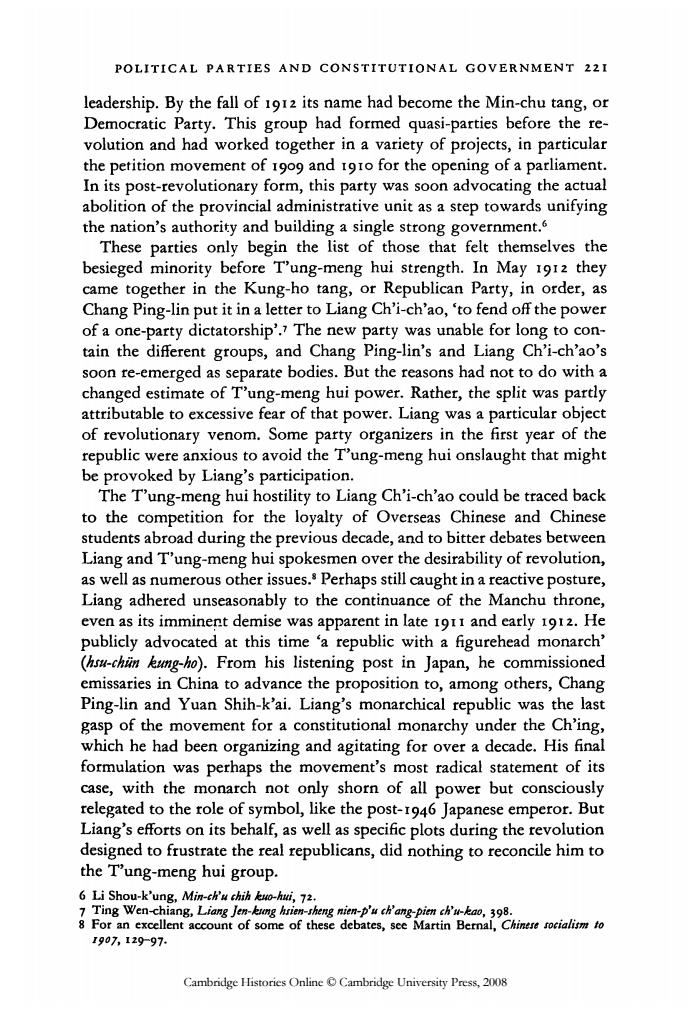正在加载图片...

POLITICAL PARTIES AND CONSTITUTIONAL GOVERNMENT 22I leadership.By the fall of 1912 its name had become the Min-chu tang,or Democratic Party.This group had formed quasi-parties before the re- volution and had worked together in a variety of projects,in particular the petition movement of 19o9 and I9to for the opening of a parliament. In its post-revolutionary form,this party was soon advocating the actual abolition of the provincial administrative unit as a step towards unifying the nation's authority and building a single strong government.s These parties only begin the list of those that felt themselves the besieged minority before Tung-meng hui strength.In May 191z they came together in the Kung-ho tang,or Republican Party,in order,as Chang Ping-lin put it in a letter to Liang Ch'i-ch'ao,to fend off the power of a one-party dictatorship'.7 The new party was unable for long to con- tain the different groups,and Chang Ping-lin's and Liang Ch'i-ch'ao's soon re-emerged as separate bodies.But the reasons had not to do with a changed estimate of Tung-meng hui power.Rather,the split was partly attributable to excessive fear of that power.Liang was a particular object of revolutionary venom.Some party organizers in the first year of the republic were anxious to avoid the T'ung-meng hui onslaught that might be provoked by Liang's participation. The T'ung-meng hui hostility to Liang Ch'i-ch'ao could be traced back to the competition for the loyalty of Overseas Chinese and Chinese students abroad during the previous decade,and to bitter debates between Liang and T'ung-meng hui spokesmen over the desirability of revolution, as well as numerous other issues.Perhaps still caught in a reactive posture, Liang adhered unseasonably to the continuance of the Manchu throne, even as its imminent demise was apparent in late 191 and early 1912.He publicly advocated at this time 'a republic with a figurehead monarch' (hsu-chfin eung-ho).From his listening post in Japan,he commissioned emissaries in China to advance the proposition to,among others,Chang Ping-lin and Yuan Shih-k'ai.Liang's monarchical republic was the last gasp of the movement for a constitutional monarchy under the Ch'ing, which he had been organizing and agitating for over a decade.His final formulation was perhaps the movement's most radical statement of its case,with the monarch not only shorn of all power but consciously relegated to the role of symbol,like the post-1946 Japanese emperor.But Liang's efforts on its behalf,as well as specific plots during the revolution designed to frustrate the real republicans,did nothing to reconcile him to the Tung-meng hui group. 6 Li Shou-k'ung,Min-ch'u chih Euo-huti,72. 7 Ting Wen-chiang,Liang Jen-king hsien-sheng nien-p'u ch'ang-pien ch'u-kao,398. 8 For an excellent account of some of these debates,see Martin Bernal,Chinere rocialism to 1907,129-97. Cambridge Histories Online Cambridge University Press,2008POLITICAL PARTIES AND CONSTITUTIONAL GOVERNMENT 221 leadership. By the fall of 1912 its name had become the Min-chu tang, or Democratic Party. This group had formed quasi-parties before the revolution and had worked together in a variety of projects, in particular the petition movement of 1909 and 1910 for the opening of a parliament. In its post-revolutionary form, this party was soon advocating the actual abolition of the provincial administrative unit as a step towards unifying the nation's authority and building a single strong government.6 These parties only begin the list of those that felt themselves the besieged minority before T'ung-meng hui strength. In May 1912 they came together in the Kung-ho tang, or Republican Party, in order, as Chang Ping-lin put it in a letter to Liang Ch'i-ch'ao, 'to fend off the power of a one-party dictatorship'.7 The new party was unable for long to contain the different groups, and Chang Ping-lin's and Liang Ch'i-ch'ao's soon re-emerged as separate bodies. But the reasons had not to do with a changed estimate of T'ung-meng hui power. Rather, the split was partly attributable to excessive fear of that power. Liang was a particular object of revolutionary venom. Some party organizers in the first year of the republic were anxious to avoid the T'ung-meng hui onslaught that might be provoked by Liang's participation. The T'ung-meng hui hostility to Liang Ch'i-ch'ao could be traced back to the competition for the loyalty of Overseas Chinese and Chinese students abroad during the previous decade, and to bitter debates between Liang and T'ung-meng hui spokesmen over the desirability of revolution, as well as numerous other issues.8 Perhaps still caught in a reactive posture, Liang adhered unseasonably to the continuance of the Manchu throne, even as its imminent demise was apparent in late 1911 and early 1912. He publicly advocated at this time 'a republic with a figurehead monarch' {hsu-chiin kung-ho). From his listening post in Japan, he commissioned emissaries in China to advance the proposition to, among others, Chang Ping-lin and Yuan Shih-k'ai. Liang's monarchical republic was the last gasp of the movement for a constitutional monarchy under the Ch'ing, which he had been organizing and agitating for over a decade. His final formulation was perhaps the movement's most radical statement of its case, with the monarch not only shorn of all power but consciously relegated to the role of symbol, like the post-1946 Japanese emperor. But Liang's efforts on its behalf, as well as specific plots during the revolution designed to frustrate the real republicans, did nothing to reconcile him to the T'ung-meng hui group. 6 Li Shou-k'ung, Min-ch'u chih kuo-hui, 72. 7 Ting Wen-chiang, Liang Jen-kung hsien-sheng nien-p'u ch'ang-pien ch'u-kao, 398. 8 For an excellent account of some of these debates, see Martin Bernal, Chinese socialism to 129-97- Cambridge Histories Online © Cambridge University Press, 2008